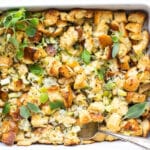
Classic Bread Stuffing
An easy Bread Stuffing made with all the classic flavors like onion, celery, and sage. Dry your bread the night before on the counter or in a 300-degree oven for 40 minutes.
Servings 10 servings (1 cup each)
Calories 231kcal
Ingredients
- 1/2 cup butter (1 stick) plus more for buttering dish
- 1 large onion chopped
- 4 celery ribs halved lengthwise and chopped
- 3 large eggs
- 2 cups chicken broth (see note 1)
- salt and freshly ground black pepper
- 1/2 cup fresh parsley minced (see note 2)
- 1 teaspoon fresh sage minced, or 1/2 teaspoon dried
- 1 teaspoon fresh thyme minced, or 1/2 teaspoon dried
- 1 teaspoon fresh marjoram minced, or 1/2 teaspoon dried
- 1 loaf French bread cut into 1/2-inch cubes and dried overnight on counter (about 1 pound, see note 3)
Instructions
- Adjust oven rack to middle position and preheat to 400 degrees. Coat a 9-inch by 13-inch baking dish with butter.
- In large skillet over medium-high heat, melt butter until foaming. Add onion and celery and sauté until translucent, about 7 to 8 minutes. Meanwhile, whisk eggs in large bowl. Stir in broth, 1 teaspoon salt, and 1/2 teaspoon pepper.
- To skillet, add parsley, sage, thyme, and marjoram until fragrant, about 30 seconds. Transfer to bowl with eggs and mix well. Add bread cubes and toss to combine. Transfer to prepared baking dish.
- Cover tightly with foil and bake until mostly heated through, about 25 minutes. Remove foil and bake until crispy edges form, about 15 to 20 minutes longer.
Video
Notes
- Chicken broth: I keep jars of homemade chicken broth in the freezer (it's a delicious by-product of poaching a chicken), but store-bought is also good. Or use turkey broth if you have that.
- Herbs: Fresh herbs taste the best in this stuffing, but dried work too. I rarely find fresh marjoram and almost always substitute dried.
- French bread: Use any sturdy bread such as Italian, challah, or sourdough bread. Dry the bread up to 3 days in advance (keep it covered with a dry kitchen towel on counter, or slice and dry in a 300-degree oven for 30 to 40 minutes).
- Yield: This Classic Bread Stuffing Recipe makes about 10 cups, enough for 10 side-dish servings of about 1 cup each.
- Storage: Store leftovers covered in the refrigerator for up to 4 days.
Nutrition
Serving: 1 cup | Calories: 231kcal | Carbohydrates: 25g | Protein: 7g | Fat: 12g | Saturated Fat: 7g | Trans Fat: 1g | Cholesterol: 80mg | Sodium: 495mg | Potassium: 194mg | Fiber: 2g | Sugar: 2g | Vitamin A: 701IU | Vitamin C: 9mg | Calcium: 48mg | Iron: 2mg